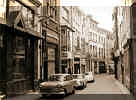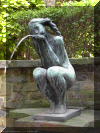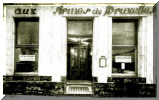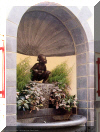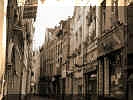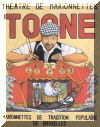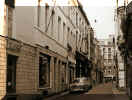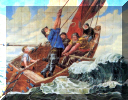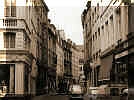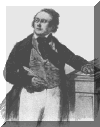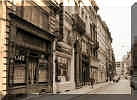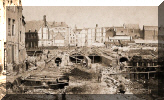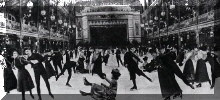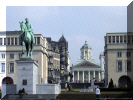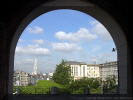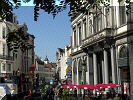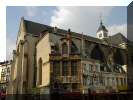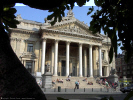For ages, three
"Rue des Bouchers" (butchers' streets) have crossed at this point :
The present Rue des Bouchers is called "Vicus Carificum" in a document from the archives of Saint-Gudule Cathedral, dating from 1294. In 1364, it is mentioned in Flemish as "Vleeshouwersstrate". In the Middle Ages it was inhabited by pork butchers, sausage merchants, tripe butchers and maybe a few authorised "bouchers" (originally, the "bouchers" were allowed to sell only "bouc" (goat) and mutton, whilst only the "Grand Boucherie", located behind the "Maison du Roi", until its collapse in 1917, was allowed to sell beef).
At number 70
was settled the splendid little "Musée de la Serrurerie" The Flemish
singer Jean de Baets
made the Rue des Bouchers famous with his fifteen-stanza song "In de rue des
Bouchers" in the 20's. This street also sheltered the "Stuart", an eclectic cinema that was inaugurated by Anna
Neagle, the star of the film Queen Victoria, in
1930. Unfortunately, this building was demolished after the Second World
War, to give way to the enlargement of a bank of the Rue d'Arenberg. Between numbers 10 and 12, at the end of the "Impasse de la Fidélité", visitors can take a look at the statue of Jeanneke Pis, the female and more realistic equivalent of the famous Manneken Pis. The statue was made in 1985 on the initiative of a merchant of the Ilot Sacré to support charity work.
Already in 1366, this street was mentioned as "Cleyn Vleeshouversstraete". However, in the 17th century, it was named "Crantje Straetje" (tap street). In the 17th century it was sometimes called "Rue du Cornet" as well.
At the beginning of the 19th century, a lot of tripe butchers came to this street, after a
prefectorial order of
the year X (revolutionary calendar) had expelled them out of the "Marché aux
Tripes" (the tripe market, which became an extension of the herbs market). The street still has
today about twelve houses dating from the 17th and 18th century. During the "Belle Époque"
(Edwardian era), the street sheltered more small music-halls than restaurants. On the first floor of number 30, there was the jazz-club "La Rose Noire", where Jacques
Brel,
the famous Belgian singer, had his first successes in 1953. Unfortunately,
for safety reasons, this successful cabaret had to close its doors in 1961. The building was bought by the restaurant "Les Armes de
Bruxelles" in 1963 and was used as the restaurant's kitchen the next
year. Nowadays, the most famous place of the Petite Rue des Bouchers is
The "Rue des Dominicains" was laid out on the gardens of the Dominicans at the beginning of the 18th century. These monks had their convent in the "Rue de l'Ecuyer" that was called Rue des Dominicains in those days, whereas the new street was originally called Rue des Bouchers.
Gradually the people of the neighborhood began to call the little street facing the entrance of the convent of the Dominicans monks the
"Petite Rue des Dominicains". As the convent was demolished in 1797, the French began to call it the "Rue de la Démolition". In 1815
however, it was again officially called Petite Rue des Dominicains to commemorate the
monks. Finally in 1851 the word "petite" (short) was let out and the street received its present
name.
As early as 1368, this street was called "Gripstraete" or "Grijpstraete". "Grijp" means fork in Flemish ("fourche" in French), but the word "grip" rather designates the heraldic griffin that can be seen on ancient coins. The street is located at the heart of the Ilot Sacré and has always had a great number of cafés, restaurants and small hotels. In 1909, the numbers 17 and 19 housed the "Grand Hotel des
This street, edged with beautiful houses dating from the 19th century, was laid
out dead straight in 1873. It came instead of two old streets that
followed the same course : the "Rue de la Coupe" and the "Rue
aux Suifs". The "Copstraet" was a right angle street of which one branch started from the "Rue Marché aux Poulets" (chickens market) and led to the north on the axis of the present Boulevard Anspach. The other branch went in the sense of the present Rue Grétry, leading to the west and ending in the middle of the former "Marché au Poisson" (fish market) that went along the right bank of the Senne river. The Rue aux Suifs (tallow's street) was the beginning of the Rue Grétry at the side of the Rue de la Fourche. In 1795, it was laid out on the ruins of the convent of the Madelonnettes, between the "Rue des Fripiers" (clothes dealers street) and the Rue de la Fourche. In the middle of its course there was a square that was successively called "Marché aux Veaux et Volailles" (veal and poultry market), "Marché aux Abats" (offal market) and finally the new "Marché aux Peaux" (leather market) around 1835. A prefectorial order dating from 1799 gave those places the names of "Rue
des Veaux" and In the Rue Grétry, under the great portal in wrought iron that rose
|
